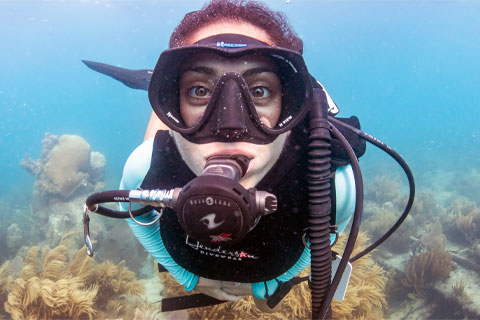From the forests of Madagascar to studying coral reefs in the deep blue waters off Cuba, University of Miami doctoral students Shireen Rahimi and Alizé Carrère have been exploring the world and gaining new scientific knowledge with the help of an Early Career Grant from National Geographic.
Now, following the launch of its inaugural On Campus program at UM in November, National Geographic is offering three new scholarships of $5,000 each exclusively to UM students studying in the fields of science, storytelling, and education.
With their own experiences under their belt, Rahimi and Carrère both advise students to create a proposal that is clear and well thought out. Rahimi believes it all begins with a good idea.
“It doesn’t matter if that idea is something really familiar or boring,” she said. “The whole point is that you are exploring something that is unknown, or in a new way, to bring a new sense of wonder into the world.”
Rahimi was award ed her grant in the summer of 2017. She got the opportunity to combine her ecological studies with photography and film to document the differences between coral reefs in Cuba and Florida. She spent the summer traveling between the two locations, exploring and studying the differences in the health of coral reefs despite their close proximity geographically.
ed her grant in the summer of 2017. She got the opportunity to combine her ecological studies with photography and film to document the differences between coral reefs in Cuba and Florida. She spent the summer traveling between the two locations, exploring and studying the differences in the health of coral reefs despite their close proximity geographically.
“I had full control of all the decision-making, so it made me want to pour my heart into it and make it a labor of love. It was really critical to developing my confidence as a filmmaker,” said Rahimi.
Carrère, who is now studying for a Ph.D. in ecosystem policy at the Abess Center, was awarded her grant in 2013 while attending McGill University in Montreal. She used the money to travel to Madagascar for three months and research how farmers were adapting to severe deforestation. Once back in Canada, Carrère said she was launched into the National Geographic community, transforming her life as she knew it.
“It’s amazing to be connected to such a tight-knit community because they do such a fantastic job of helping you succeed,” she said. “I’ve done many unique things for the brand. I even ended up working for Lindblad/National Geographic Expeditions, leading voyages aboard the National Geographic Orion.”
Her initial expedition inspired her to continue her research and apply for two other grants where she traveled to Bangladesh and India to study how communities are innovatively adapting to climate-related changes on a landscape level.
Carrère’s journey shows how an idea can flourish into something bigger than first thought. She urges future students who are interested in applying for a grant to reach out to professors for support.
“I think that’s something a lot of undergraduate students tend to underutilize as a resource. Reaching out for help is such a good way to get ideas, especially if they are specializing in research connected to what you’re interested in,” said Carrère.
Rahimi is now motivated to continue pursing photography and filmmaking in the future.
“I’m interested in creating content that tells the story of people who are living on a changing planet,” said Rahimi. “I want to make sure my work is different and new, but also speaks to wide audiences, especially in the face of climate threats that have already transformed the world we live in.”
Carrère continues to work on a digital series that she started thanks to support from her National Geographic grants. She said through this journey she’s grown to love science communication.
“I’ve learned the power of communication when it comes to sharing very difficult and complex subjects. National Geographic is all about the visuals. They train you how to share these messages that impact a wider audience,” said Carrère.
Applications for the National Geographic On Campus Scholarship are due by March 30, 2019.
National Geographic On Campus Scholarship

